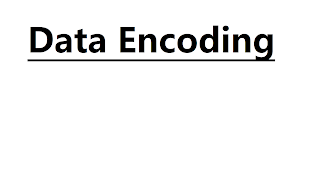Demystifying Data Encoding: A Guide to Label Encoding and One-Hot Encoding
What is Data Encoding ?
Encoding means translating data into a format that computers can use.
There are two main types:
1. Label Encoding:
- Imagine you have a list of sizes: Small, Medium, Large.
- Label Encoding gives them numbers: 0, 1, 2.
- It's like creating a list where each item has a number assigned.
2. One-Hot Encoding:
- Now, think of colors: Red, Green, Blue.
- One-Hot Encoding makes boxes: Red, Green, Blue.
- If something is Red, the Red box gets a checkmark (1); the others get Xs (0s).
- It's like creating checkboxes for each option.
Both are used to convert categorical data into a numerical format that machine learning algorithms can understand
Here I try to explain in briefly.
1. Label Encoding:
Description: Label Encoding assigns a unique integer (label) to each category or class within a categorical feature. It converts categorical data into ordinal data, which implies an order among the categories. Label Encoding is suitable for ordinal categorical variables where the order matters.
Example: Consider a categorical feature "Size" with values ["Small", "Medium", "Large"]. Label Encoding might map them to [0, 1, 2], respectively.
python
from sklearn.preprocessing import LabelEncoder
# Create a sample dataset
data = ["Small", "Medium", "Large", "Small", "Large"]
# Initialize the label encoder
label_encoder = LabelEncoder()
# Fit and transform the data
encoded_data = label_encoder.fit_transform(data)
print(encoded_data)
- Use Cases: Label Encoding is useful when there's a natural order or hierarchy among the categories, such as "Low," "Medium," and "High" or "Cold," "Warm," and "Hot." However, it may introduce unintended ordinal relationships that do not exist, which can mislead some machine learning algorithms.
2. One-Hot Encoding:
Description: One-Hot Encoding converts categorical variables into a binary matrix (0s and 1s). It creates a new binary feature (dummy variable) for each category in the original categorical feature. Each feature represents the presence or absence of a category. One-Hot Encoding is suitable for nominal categorical variables where there is no inherent order among the categories.
Example: Using the "Size" feature again, One-Hot Encoding would create three new binary features: "Small," "Medium," and "Large," with values [1, 0, 0], [0, 1, 0], and [0, 0, 1], respectively.
python
import pandas as pd
# Create a sample dataset
data = ["Small", "Medium", "Large", "Small", "Large"]
# Perform One-Hot Encoding using pandas
encoded_data = pd.get_dummies(data, prefix='Size')
print(encoded_data)- Use Cases: One-Hot Encoding is preferred when there is no intrinsic order or ranking among categories, and you want to prevent the model from assuming any ordinal re
- lationship between them. It helps prevent potential bias in algorithms that can misinterpret ordinal labels.
Why We Use Them:
Machine Learning Compatibility: Many machine learning algorithms require numerical input data. Categorical variables must be encoded to enable these algorithms to process the data effectively.
Preventing Bias: Encoding categorical variables correctly helps prevent introducing unintended ordinal relationships among categories, ensuring that the model does not make incorrect assumptions.
Feature Expansion: One-Hot Encoding can be especially useful when dealing with categorical variables with multiple categories. It expands the feature space but allows the model to treat each category independently.
Algorithm Compatibility: Some machine learning algorithms, like decision trees and random forests, can handle categorical data directly. However, many others, like linear regression or support vector machines, require encoding to work with categorical features.
In practice, the choice between Label Encoding and One-Hot Encoding depends on the nature of your categorical variables and the requirements of the machine learning algorithm you're using. It's essential to understand the data and select the appropriate encoding technique accordingly.
And one-more thing One-hot encoding and label encoding are both methods of encoding categorical data in the context of machine learning and data analysis. These encoding techniques fall under the category of "categorical encoding."

Comments
Post a Comment